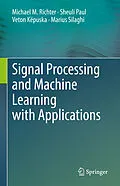Autorentext
Professor Michael M. Richter taught at the University of Texas at Austin and at RWTH Aachen, in addition to numerous visiting professorships. He is one of the founding scientific director of the DFKI (German Research Center for Artificial Intelligence). He taught, researched, and published extensively in the areas of mathematical logic and artificial intelligence. Professor Richter was one of the pioneers of case-based reasoning: he founded the leading European event on the subject, he led many of the key academic research projects, and demonstrated the real-world viability of the approach with successful commercial products. Michael Richter passed away during the final publishing phase of this book.
Dr. Sheuli Paul is a scientist in Defence Research and Development Canada, engaged in applied research in the areas of signal processing, machine learning, artificial intelligence and human-robot interaction. Trying to solve complex problems in interdisciplinary areas is her passion.
Dr. Veton Këpuska is an inventor of Wake-Up-Word Speech Recognition, a method of communication with machines for which he was granted two patents. He joined Florida Institute of Technology (FIT) in 2003 and engaged in numerous research activities in speech and image processing, digital processes, and machine learning. Dr. Këpuska won the First Annual Digital Signal Processing Design competition by applying his Wake-up-Word on embedded Analog Devices Platform. Dr. Këpuska won numerous awards including "the Kerry Bruce Clark" award for teaching excellence and received numerous best paper awards.
Prof. Marius Silaghi has taught, researched, and published in the areas of artificial intelligence and networking. Professor Silaghi is involved in human-machine interaction research and proposed techniques for motion capture, speech recognition, and robotics. He founded the conference on Distributed Constraint Optimization and gave multiple tutorials on the topic at the main artificial intelligence conferences. He received numerous best paper awards.
Klappentext
Signal processing captures, interprets, describes and manipulates physical phenomena. Mathematics, statistics, probability, and stochastic processes are among the signal processing languages we use to interpret real-world phenomena, model them, and extract useful information. This book presents different kinds of signals humans use and applies them for human machine interaction to communicate.
Signal Processing and Machine Learning with Applications presents methods that are used to perform various Machine Learning and Artificial Intelligence tasks in conjunction with their applications. It is organized in three parts: Realms of Signal Processing; Machine Learning and Recognition; and Advanced Applications and Artificial Intelligence. The comprehensive coverage is accompanied by numerous examples, questions with solutions, with historical notes. The book is intended for advanced undergraduate and postgraduate students, researchers and practitioners who are engaged with signal processing, machine learning and the applications.
Inhalt
Part A, Signal Processing and Spectral Analysis.- Signal Processing Background.- Fundamentals of Signal Transformation.- Digital Filters: Finite Impulse Response (FIR) and Infinite Impulse Response (IIR) Filters.- Estimation and Detection.- Adaptive Signal Processing.- Spectral Analysis.- Part B, Machine Learning and Recognition.- General Learning.- Stochastic Processes.- Feature Extraction.- Fundamentals of Probability for Signal Processing.- Machine Learning and Its Role in Signal Processing.- Unsupervised Learning.- Markov Model and Hidden Stochastic Model (HSM).- Fuzzy Logic and Rough Sets.- Neural Networks.- Part C, Practical Aspects and Applications.- Noisy Signals.- Reasoning Methods and Noise Removal Techniques.- Audio Signals and Speech Recognition.- Noisy Speech.- Aspects of Human Hearing.- Speech Features.- Hidden Stochastic Model for Speech.- Different Speech Applications.- Biomedical Signals: ECG and EEG Signals.- Seismic Signals.- Radar Signal Processing.- Digital Processes and Multimedia.- Visual Analytics (VA) and Visual Story Telling (VST).- Visualizations for Emergency Operation Centre (EOC).- Intelligent Machine for Interactive Communications.- Comparisons.
